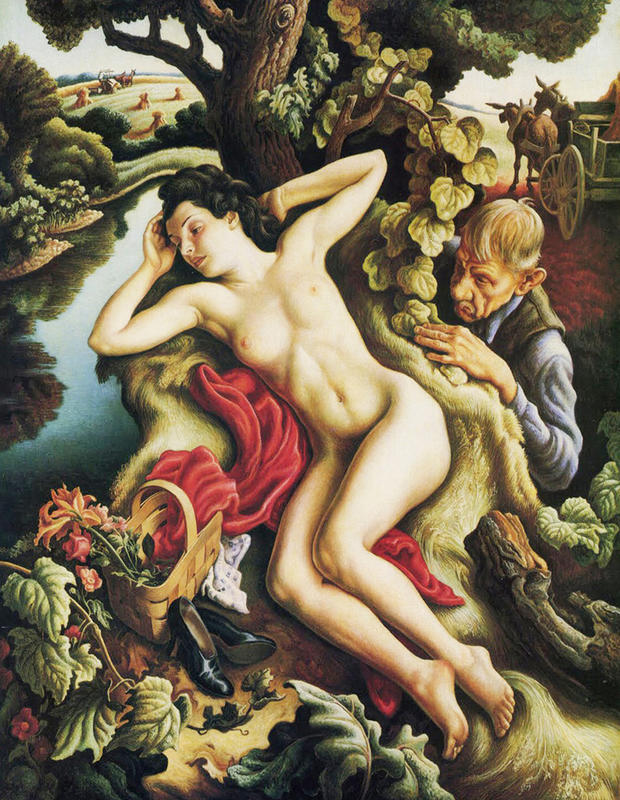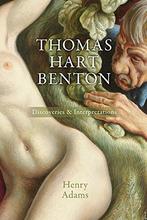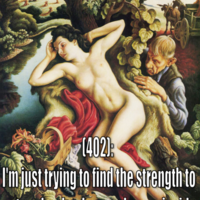More about Persephone
- All
- Info
- Shop

Sr. Contributor
Thomas Hart Benton tries to get 1930's middle-America to love him with a giant nude of Persephone. It doesn't work.
America’s reaction to Persephone did not exemplify a broad and European approach to the arts. Described as “fit for a Moscow Subway”, compared to a pinup calendar, hung for years in a New York nightclub called “The Diamond Horseshoe,” cited by contemporary art critic Karal Ann Marling as "one of the great works of American pornography,” Persephone would get Benton fired from his teaching job at the Kansas City Art Institute and later mark him as the creator of the “Mona Lisa” of Kansas City.
In 1935, Benton left his teaching post at New York’s Art Students League for his home-state of Missouri. Officially the reason for the move was opportunity, he’d earned a mural commission for the Missouri State Capitol in Jefferson City and was offered a position as head of the painting department for the Kansas City Art Institute. In actuality, he was no longer welcome in New York after making numerous homophobic remarks about curators, generally refusing to conform to the leftist politics of the community, and having a style that had been outmoded by modernism. What do you do when the hub of the American art world tells you that your style and social opinions are too old fashioned and folksy? Obviously you incorporate more tired mythological and pastoral tropes into your paintings while asserting your masculinity through the display of a hot young woman fully nude being subjected to a pervy old man.
Alright, it’s unfair to dismiss this piece because of its use of mythology or the male gaze. Beyond the striking beauty of the painting there is a lot of cool autobiographical and social symbolism worth noting. Unfortunately, you may not notice that symbolism without a refresher course in Greek mythology, so here goes: Persephone was the daughter of Demeter, the goddess of the harvest. Persephone was a total dish who caught the eye of Hades, the god of the underworld. Well, one day he decided leering wasn’t good enough so he abducted our heroine and took her on a Tunnel-o-love ride down the River Styx. Demeter was none-to-pleased and decided she would make the Earth barren until her daughter was returned. After some custody negotiations, Persephone wound up spending half of the year with her mother and half with Hades. The months in which Demeter and her daughter are together, the Earth is blessed with the warmth of their love and we have our Spring and Summer, when they are separated poor Demeter demonstrates that misery loves company by ushering in the Fall and Winter seasons.
Beyond the title, which tellingly was originally The Rape of Persephone, it now becomes clear that the lecherous farmer is our Hades figure with his cart acting as a rape van chariot. He also bears a striking resemblance to the artist who had admitted that he lusted after the nude model who was “so beautiful that you go away muttering for the rest of the day.” The farmer, who was actually based off of a live male model, also purposefully resembles Benton’s father. This brings up a whole other autobiographical layer when it’s considered that Benton’s parents were reported to have a terrible relationship; Benton recalls hearing his mother’s terrified cries of protestation as his father fulfilled his matrimonial duties. So we have the artist connecting this to voyeuristic moments hearing his folks act out the abduction scene, while also commenting on his and the viewer’s voyeurism when confronted with young beauty. Here is where we get to the theme that makes this painting so decidedly American, especially during the Depression; the desire for youth, fertility in land and women (we need sons to work that fertile farmland!), and the promise of Spring, i.e. an economic and agricultural reawakening.
Spring, fertility, youth… I guess these things can be summed up without knowledge of the myth with one look at those beautiful breasts. And guess what pervs? They were painted from a live model! Ms. Imogen Bruton took to art modelling at the Kansas City Art Institute out of desperation during the Depression. Story has it that during one of her earliest sessions she completely collapsed from hunger; there was lots of blood. The poor woman quit modelling at the college soon after the painting was completed, married, had a son, and declined any further association with Benton or the famous nude. Benton left the college soon afterwards, not due to abashment and family, but once again his poor attitude. He’d gone against the college’s wishes in painting Persephone and rather than behaving apologetically he continued his trend from New York and called everyone against him homophobic slurs. And yet, he remains one of the great American artists of the early 20th Century!
Featured Content
Here is what Wikipedia says about Persephone (painting)
Persephone is a 1939 painting by the American artist Thomas Hart Benton. It depicts the Greek goddess Persephone resting nude beside a tree in a rural Midwestern landscape while a farmer, standing in for Pluto, peeks out from behind the tree. The belief that Benton modeled the farmer after himself is a common misconception.
It was painted at the Kansas City Art Institute where Benton worked as a teacher. Several of Benton's students also made their own versions of the subject. A reporter from Life visited Benton in his studio during his work on this painting and his other famous nude painting from the same period, Susanna and the Elders.
The model for Persephone was Imogene Bruton. Bruton modeled for students at the school in the 1930s but abandoned modeling after completing Persephone. She married in 1940, and was later unwilling to talk about her time as a model.
Overview
The painting measures 72 ⅛ by 56 1/16 inches (183.2 by 142.4 cm) and was executed in tempera with oil glazes on canvas mounted on panel. The Nelson-Atkins Museum of Art in Kansas City bought the painting in 1986. The museum paid $2,500,000, which was a new record for a Benton painting. The painting depicts the Greek goddess Persephone nude at rest beside a tree in a verdant creek-side setting rendered in greens, reds, and blues. The figure of Hades appears as an aging farmer in contemporary work clothes, positioned behind the tree, peering voyeuristically at the sleeping goddess. A rickety horse-drawn cart, a farmhouse, and a Model T automobile occupy the middle distance.
The painting inspired Imogen and Twinka at Yosemite, a 1974 photograph by Judy Dater.
Check out the full Wikipedia article about Persephone (painting)














